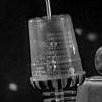When you insert an xref, there is an option in the "Attach External Reference" dialog where you can set the insertion point, or you can just grab the xref and move it after insertion, but I wouldn't recommend doing either of these things. It's bad practice to move xrefs, especially if they contain survey information or items that need to line up with other xrefs. You're setting yourself up for problems if you get into the habit of moving xrefs.
If it were me, and I needed to see each xref without them overlapping, I would insert the xrefs and then set up layouts in paper space with viewports for each xref. Within each viewport I would turn off the xrefs I don't want to see. So in the case of your example, I would have 3 viewports, one for each xref.
